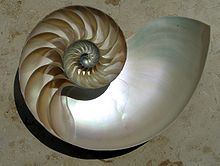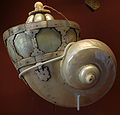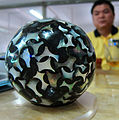- Nacre
-
"Mother of pearl" redirects here. For other uses, see Mother of pearl (disambiguation).
Part of a series on Seashells 
Mollusk shells About mollusk shells - Conchology
- Nacre
- Valve
Other seashells  The iridescent nacre inside a Nautilus shell.
The iridescent nacre inside a Nautilus shell.
Nacre (
 /ˈneɪkər/[1] nay-kər), also known as mother of pearl, is an organic-inorganic composite material produced by some mollusks as an inner shell layer; it is also what makes up pearls. It is very strong, resilient, and iridescent.
/ˈneɪkər/[1] nay-kər), also known as mother of pearl, is an organic-inorganic composite material produced by some mollusks as an inner shell layer; it is also what makes up pearls. It is very strong, resilient, and iridescent.Nacre is found in some of the more ancient lineages of bivalves, gastropods and cephalopods. However, the inner layer in the great majority of mollusk shells is porcellaneous, not nacreous, and this usually results in a non-iridescent shine, or more rarely in non-nacreous iridescence such as flame structure as is found in conch pearls.
Pearls and the inside layer of pearl oyster and freshwater pearl mussel shells are made of nacre. Many other families of mollusk also have a nacreous inner shell layer, including marine gastropods such as the Haliotidae, the Trochidae and the Turbinidae.
Contents
Appearance
Nacre appears iridescent because the thickness of the aragonite platelets is close to the wavelength of visible light. This results in constructive and destructive interference of different wavelengths of light, resulting in different colors of light being reflected at different viewing angles.
Structure
Nacre is composed of hexagonal platelets of aragonite (a form of calcium carbonate) 10-20 µm wide and 0.5 µm thick[2] arranged in a continuous parallel lamina.[2] These layers are separated by sheets of organic matrix composed of elastic biopolymers (such as chitin, lustrin and silk-like proteins). This mixture of brittle platelets and the thin layers of elastic biopolymers makes the material strong and resilient, with a Young's modulus of 70 GPa. Strength and resilience are also likely to be due to adhesion by the "brickwork" arrangement of the platelets, which inhibits transverse crack propagation. This design at multiple length sizes increases its toughness enormously, making it almost equivalent to that of silicon.
The crystallographic c-axis points perpendicular to the shell wall, but the direction of the other axes varies between groups. In bivalves and cephalopods, the b-axis points in the direction of shell growth, whereas in the monoplacophora it is the a-axis that is this way inclined.[3] The interlocking of bricks of nacre has large impact on both the deformation mechanism as well as toughness of nacre.[4] In addition, the mineral - organic interface results in enhanced resilience and strength of the organic interlayers.[5] [6] [7]
Formation
Nacre formation is mediated by the organic matrix, which controls the onset, duration and form of crystal growth.[8] Individual aragonite "bricks" quickly grow to the full height of the nacreous layer, and expand until they abut adjacent bricks.[3] Bricks nucleate on randomly-dispersed elements within the organic layer.[9] This produces the hexagonal close-packing characteristic of nacre.[3] Nacre differs from fibrous aragonite – a brittle mineral of the same form – in that the growth in the c-axis (i.e. perpendicular to the shell, in nacre) is slow in nacre, and fast in fibrous aragonite.[10]
Function
Nacre is secreted by the epithelial cells of the mantle tissue of various molluscs. The nacre is continuously deposited onto the inner surface of the shell, the iridescent nacreous layer, commonly known as mother of pearl. The layers of nacre smooth the shell surface and help defend the soft tissues against parasites and damaging debris by entombing them in successive layers of nacre, forming either a blister pearl attached to the interior of the shell, or a free pearl within the mantle tissues. The process is called encystation and it continues as long as the mollusk lives.
Evolution
Main article: Mollusc shell#EvolutionThe form of nacre varies from group to group. In bivalves, the nacre layer is formed of single crystals in a hexagonal close packing. In gastropods, crystals are twinned, and in cephalopods, they are pseudohexagonal monocrystals, which are often twinned.[3]
Commercial sources
Currently the chief sources of mother of pearl are the pearl oyster, freshwater pearl mussels, and to a lesser extent, abalone. Widely used for pearl buttons especially during the 1900s, were the shells of the great green turban snail Turbo marmoratus and the large top snail, Trochus niloticus.
Decorative uses
Nacre has been used over many centuries for all kinds of decorative purposes:
-
Altarpiece, circa 1520, with extensive use of carved nacre.
-
Inlay with nacre tesserae, Bagdad pavilion, Topkapı Palace, Istanbul.
Architecture
Both black and white nacre are used for architectural purposes. The natural nacre may be artificially tinted to almost any color. Nacre tesserae may be cut into shapes and laminated to a ceramic tile or marble base. The tesserae are hand-placed and closely sandwiched together, creating an irregular mosaic or pattern (such as a weave). The laminated material is typically about 2 mm thick. The tesserae are then lacquered and polished creating a durable and glossy surface.
Instead of using a marble or tile base, the nacre tesserae can be glued to fiberglass. The result is a lightweight material that offers a seamless installation and there is no limit to the sheet size. Nacre sheets may be used on interior floors, exterior and interior walls, countertops, doors and ceilings. Insertion into architectural elements, such as columns or furniture is easily accomplished.
Fashion
Mother of pearl buttons are often used in clothing either for functional or decorative purposes. The Pearly Kings and Queens are an elaborate example of this.
Nacre is also used to decorate watches, knives, guns and jewelry.
Musical instruments
Nacre inlay is often used for key touches and other decorative motifs on musical instruments. Many accordion and concertina bodies are completely covered in nacre, and some guitars have fingerboard or headstock inlays made of nacre (as well as some guitars having plastic inlays designed to imitate the appearance of nacre). Greek bouzouki and baglamas instruments typically feature nacre decorations. Bows of stringed instruments like the violin and cello often have mother of pearl inlay at the frog.
Other
Mother of pearl is used to make spoon-like utensils for caviar, so as to not spoil the taste with metallic spoons.
See also
References
- ^ Definition of nacre at dictionary.com.]
- ^ a b Nudelman, F.; Gotliv, B. A.; Addadi, L.; Weiner, S. (2006). "Mollusk shell formation: Mapping the distribution of organic matrix components underlying a single aragonitic tablet in nacre". Journal of Structural Biology 153 (2): 176. doi:10.1016/j.jsb.2005.09.009. PMID 16413789.
- ^ a b c d Checa, A.; Ramírez-Rico, J.; González-Segura, A.; Sánchez-Navas, A. (2009). "Nacre and false nacre (foliated aragonite) in extant monoplacophorans (=Tryblidiida: Mollusca)". Die Naturwissenschaften 96 (1): 111–122. Bibcode 2009NW.....96..111C. doi:10.1007/s00114-008-0461-1. PMID 18843476.
- ^ Platelet interlocks are the key to toughness and strength in nacre Katti KS, Katti DR, Pradhan SM, Bhosle A JOURNAL OF MATERIALS RESEARCH Volume: 20 Issue: 5 Pages: 1097-1100 Published: MAY 2005
- ^ Ghosh P, Katti DR, Katti KS Mineral and protein-bound water and latching action control mechanical behavior at protein-mineral interfaces in biological nanocomposites JOURNAL OF NANOMATERIALS Article Number: 582973 Published: 2008
- ^ Mohanty B , Katti KS , Katti DR Experimental investigation of nanomechanics of the mineral-protein interface in nacre MECHANICS RESEARCH COMMUNICATIONS Volume: 35 Issue: 1-2 Pages: 17-23 Published: JAN-MAR 2008
- ^ Ghosh P, Katti DR, Katti KS Mineral proximity influences mechanical response of proteins in biological mineral-protein hybrid systems BIOMACROMOLECULES Volume: 8 Issue: 3 Pages: 851-856 Published: MAR 2007
- ^ Jackson, D.; McDougall, C.; Woodcroft, B.; Moase, P.; Rose, R.; Kube, M.; Reinhardt, R.; Rokhsar, D. et al. (2010). "Parallel evolution of nacre building gene sets in molluscs". Molecular biology and evolution 27 (3): 591–608. doi:10.1093/molbev/msp278. PMID 19915030.
- ^ Addadi, L.; Joester, D.; Nudelman, F.; Weiner, S. (2006). "Mollusk Shell Formation: A Source of New Concepts for Understanding Biomineralization Processes". ChemInform 37 (16). doi:10.1002/chin.200616269.
- ^ Bruce Runnegar & S Bengtson. "1.4 Origin of Hard Parts — Early Skeletal Fossils". http://www.earth-pages.co.uk/Pages%2016-30,%20Section%201.pdf.
Further reading
- Frýda J., Bandel K. & Frýdová B. (2009). "Crystallographic texture of Late Triassic gastropod nacre: evidence of long-term stability of the mechanism controlling its formation". Bulletin of Geosciences 84(4): 745-754. doi:10.3140/bull.geosci.1169.
- Lin, A.; Meyers, M.A. (2005-01-15). "Growth and structure in abalone shell". Materials Science and Engineering A 390 (1-2): 27–41. doi:10.1016/j.msea.2004.06.072. http://www.sciencedirect.com/science?_ob=ArticleURL&_udi=B6TXD-4DH2DRS-1&_coverDate=01%2F15%2F2005&_alid=256050522&_rdoc=1&_fmt=&_orig=search&_qd=1&_cdi=5588&_sort=d&view=c&_acct=C000050221&_version=1&_urlVersion=0&_userid=10&md5=f4efd0a3d7cf3b4a0b8f9861cff4514d.
- Mayer, G. (2005). "Rigid biological systems as models for synthetic composites". Science 310 (5751): 1144–1147. doi:10.1126/science.1116994. PMID 16293751.
- Bruet, B.; et al. (September 2005). "Nanoscale morphology and indentation of individual nacre tablets from the gastropod mollusc Trochus niloticus". J. Mater. Res. 20 (9): 2400. doi:10.1557/JMR.2005.0273. http://web.mit.edu/cortiz/www/Ben/BenPaperRevisedFinal.pdf.
External links
Categories:- Mollusc products
- Pearls
- Mollusc anatomy
Wikimedia Foundation. 2010.





